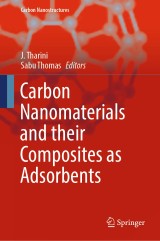Details
Carbon Nanomaterials and their Composites as Adsorbents
Carbon Nanostructures
|
149,79 € |
|
| Verlag: | Springer |
| Format: | |
| Veröffentl.: | 26.04.2024 |
| ISBN/EAN: | 9783031487194 |
| Sprache: | englisch |
Dieses eBook enthält ein Wasserzeichen.
Beschreibungen
This book elucidates fundamental concepts of nanomaterials and their pivotal role as nanoadsorbents in water purification. Key features include the latest trends in adsorption for metal, micro pollutants, food adulterants, aromatic compounds, pesticides, dyes, and oil particle removal. Additionally, the interdisciplinary aspects of adsorption and practical applications for hazardous chemical removal from water are explored. The book delves into various types of adsorption isotherms such as Langmuir, Freundlich, BET, and others, offering a deep understanding for water purification. Kinetic models including first, second, and third order kinetics are elucidated, empowering undergraduate students to grasp and optimize complex systems. The required background is basic knowledge in chemistry, biology, mathematics, and nanoscience at the first-year university level. Designed for both academics and industrial researchers, this book is divided into 17 chapters. Chapters 1-7 introduce nanomaterials, carbon nanoadsorbents, their synthesis, and surface modification. Chapters 8-9 cover fundamental adsorption isotherms, kinetic models, thermodynamic parameters, adsorption mechanism, and experimental techniques. Chapters 10-15 delve into the adsorption and desorption of various compounds like aromatic compounds, pesticides, heavy metals, micro pollutants, food adulterants, oil particles, and dyes molecules. The final chapter tackles the theoretical modeling of carbon nanomaterials for adsorption studies
Introduction to Nanomaterials.- Carbon Nanoadsorbents.- Carbon Nanomaterials and their Composites as Adsorbents.- Biological properties of carbon based materials.- Synthesis Strategies of Various Carbon Materials.- Surface Modification and Engineering of Nanscale Adsorbent and their Composite.- Application and research progress of nanomaterials as adsorbents in environment field.- Adsorption Isotherm and Kinetic Model.- Adsorption and Desorption of Adulterants in the Food Industry.- Adsorption and desorption of Micropollutants.- Recent trends in the adsorption and desorption of heavy metals.- Carbon nanomaterials for Adsorption and Desorption of Pesticides.- Adsorption and desorption of dyes.- Two-dimensional carbon-based materials for sorption of selected aromatic compounds in water.- Purification of Water Using Carbon Nanomaterials.-<b> </b>Mathematical modeling of Nonlinear Vibrations of Single-Walled CarbonNanotubes.<br><b> </b>
This book elucidates fundamental concepts of nanomaterials and their pivotal role as nanoadsorbents in water purification. Key features include the latest trends in adsorption for metal, micro pollutants, food adulterants, aromatic compounds, pesticides, dyes, and oil particle removal. Additionally, the interdisciplinary aspects of adsorption and practical applications for hazardous chemical removal from water are explored. The book delves into various types of adsorption isotherms such as Langmuir, Freundlich, BET, and others, offering a deep understanding for water purification. Kinetic models including first, second, and third order kinetics are elucidated, empowering undergraduate students to grasp and optimize complex systems. The required background is basic knowledge in chemistry, biology, mathematics, and nanoscience at the first-year university level. Designed for both academics and industrial researchers, this book is divided into 17 chapters. Chapters 1-7 introduce nanomaterials, carbon nanoadsorbents, their synthesis, and surface modification. Chapters 8-9 cover fundamental adsorption isotherms, kinetic models, thermodynamic parameters, adsorption mechanism, and experimental techniques. Chapters 10-15 delve into the adsorption and desorption of various compounds like aromatic compounds, pesticides, heavy metals, micro pollutants, food adulterants, oil particles, and dyes molecules. The final chapter tackles the theoretical modeling of carbon nanomaterials for adsorption studies
Cutting-edge Insights in Nanoadsorbent Technology Comprehensive Coverage of nanomaterials from Basics to Advanced Research Practical Applications for Hazardous Chemical Removal
Diese Produkte könnten Sie auch interessieren:

Structural Dynamics in Engineering Design

von: Nuno M. M. Maia, Dario Di Maio, Alex Carrella

97,99 €

















